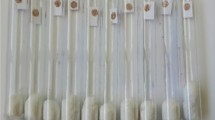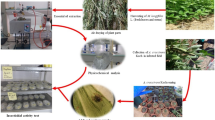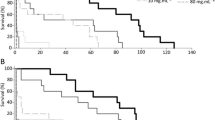Abstract
Rhamnus persica Boissier from the family Rhamnaceae is a valuable medicinal plant in the flora of Iran. The parasitoid wasp, Habrobracon hebetor Say, is a universal biological control agent collected by researchers on lepidopteran larvae in various agricultural and horticultural crops. In the present study, the insecticidal effects of R. persica essential oil (RPEO) were investigated on this parasitoid wasp for the first time. For demographic studies, H. hebetor females were treated with LC30 (sublethal concentration) of the RPEO for 24 h and the desired characteristics were examined about them. The results of Gas Chromatography-Mass Spectrometry showed that the compounds including 1, 4-Hexadiene, 4-Methyl; Borneol L; Bicyclo [2.2.1] Heptan-2-ol; 1, 8-Cineole 2-Oxabicyclo, and Bicyclo [3.1.1] Hept-2-en-4-ol were five major constituents of the essential oil, respectively. Also, the bioassay results showed that LC30, LC50, and LC90 values for the RPEO on the parasitoid wasp were 12.51, 39.91, and 678.94 µL/Liter air, respectively. Moreover, the sublethal results showed that adult the wasp’s lifespan, survival, fecundity, fertility, hatch rate, sex ratio, and the other related parameters were negatively affected compared to the control population; but, the effects were not very severe. Therefore, RPEO can be combined with H. hebetor in integrated pest management programs.


Similar content being viewed by others
References
Abedi Z, Saber M, Gharekhani G, Mehrvar A, Kamita SG (2014) Lethal and sublethal effects of azadirachtin and cypermethrin on Habrobracon hebetor Say (Hymenoptera: Braconidae). J Econ Entomol 107:638–645
Abramson CI, Wanderley PA, Wanderley MJA, Mina AJS, De Souza OB (2006) Effect of essential oil from citronella and alfazema on fennel aphids Hyadaphis foeniculi Passerini (Hemiptera: Aphididae) and its predator Cycloneda sanguinea L. (Coleoptera: Coccinellidae). Am J Environ Sci 3(1):9–10
Ahmadpour R (2017) The effects of isolated essential oils from four medicinal plants on the ectoparasitoid wasp, Habrobracon hebetor Say, under laboratory conditions. M.Sc. Thesis. University of Mohaghegh Ardabili, Ardabil, Iran
Ajayi FA, Olonisakin A (2011) Bioactivity of three essential oils isolated formidable seeds on the red flour beetle Tribolium castaneum (Herbest) infesting stored pearl millet. Trakia J Sci 9(1):28–36
Ainane A, Khammour F, Charaf S, Elabboubi M, Elkouali M, Talbi M, Benhima R, Cherroud S, Ainane T (2019) Chemical composition and insecticidal activity of five essential oils: Cedrus atlantica, Citrus limonum, Rosmarinus officinalis, Syzygium aromaticum and Eucalyptus globules, Materialstoday: Proceedings, 13(3): 478–485
Asadi M, Nouri-Ganbalani G, Rafiee-Dastjerdi H, Hassanpour M, Naseri B (2018) The effects of Rosmarinus officinalis L. and Salvia officinalis L. (Lamiaceae) essential oils on demographic parameters of Habrobracon hebetor say (Hym.: Braconidae) on Ephestia kuehniella Zeller (Lep.: Pyralidae) Larvae. J Essent Oil-Bear Plants 21(3):713–731
Asadi M, Rafiee-Dastjerdi H, Nouri-Ganbalani G, Naseri B, Hassanpour M (2019) Insecticidal activity of the isolated essential oils from three medicinal plants on the biological control agent, Habrobracon hebetor Say (Hymenoptera: Braconidae). Acta Biol Szeged 63(1):63–68
Babaee Ghaghelestany A, Alebrahim MT, Asadi M (2020) Chemical analysis and identifying dominant essential oils compositions from sage (Salvia officinalis L). Food Sci Technol 17(101):155–165
Bakkali F, Averbeck S, Averbeck D, Idomar M (2008) Biological effects of essential oils. Food Chem Toxicol 46:446–475
Borzoui E, Naseri B, Abedi Z, Karimi-Pormehr MS (2016) Lethal and sublethal effects of essential oils from Artemisia khorassanica and Vitex pseudo-negundo against Plodia interpunctella (Lepidoptera: Pyralidae). Environ Entomol 45(5):1220–1226
Carey JR (1993) Applied Demography for biologists with special emphasis on insects. Oxford University Press, New York
Croft BA (1990) Arthropod Biological Control Agents and Pesticides. John Wiley and Sons, New York
Desneux N, Decourtye A, Delpuech JM (2007) The sublethal effects of pesticides on beneficial arthropods. Annu Rev Entomol 52:81–106
Forbes VE, Calow P (1999) Is the per capita rate of increase a good measurement of population level-effect of in ecotoxicology?. Environ Toxicol Chem 18:1544–1556
Hamedi N, Fathipour Y, Saber M (2010) Sublethal effects of fenpyroximate on life table parameters of the predatory mite, Phytoseius plumifer. BioControl 55:271–278
Hamedi N, Fathipour Y, Saber M (2011) Sublethal effects of abamectin on the biological performance of the predatory mite, Phytoseius plumifer (Canestrini & Fanzago) (Acari: Phytoseiidae). Exp Appl Acarol 53:29–40
Hashemi Z, Goldansaz H, Hosseini-Naveh V (2014) Effects of essential oil of Ferula assafoetida L. on biological parameters of the parasitoid wasp, Habrobracon hebetor (Hym.: Braconidae), under laboratory conditions. Proceed 21th Iran Plant Protect Congress, 9–13 September, University of Urmia, Iran
Isman MB, Wilson JA, Bradbury F (2008) (Rosmarinus officinalis) against larvae of Pseudaletia unipunctata and Trichoplusia ni in relation to their chemical compositions. Pharm Biol 46(1–2):82–87
Kramer S, Gvozdic V (2016) Field studies of the efficacy of some commercially available essential oils against horse flies (Diptera: Tabanidae). Entomol Gen 36(2):97–105
Koul O, Walia S, Dhaliwal GS (2008) Essential oils as green pesticides: potential and constraints. Biopest Inter 4(1):63–84
Kurylo JS, Knight KS, Stewart JR, Endress AG (2007) Rhamnus cathartica: native and naturalized distribution and habitat preferences. J Torrey Bot Soc 134(3):420–430
Magro SR, Parra JRP (2001) Biologia do ectoparasitoide Bracon hebetor Say (Hymenoptera: Braconidae) em sete especies de lepidopteros. Sci Agri 58:693–698
Mahdavi V (2013) Residual toxicity of some pesticides on the larval ectoparasitoid Habrobracon hebetor Say (Hymenoptera: Braconidae). J Plant Prot Res 53:27–32
Mahmoudvand M, Abbasipour H, Basij M, Hosseinpour MH, Rastegar F, Nasiri MB (2011) Fumigant toxicity of some essential oils on adults of some stored-products pests. Chile J Agric Res 71(1):83–89
Manzoor F, Nasim G, Saif S, Malik SA (2011) Effect of ethanolic plant extracts on three storage green pests of economic importance. Pakistan J Biotechnol 43(6):2941–2946
Meyer JS, Ingersoll CG, Mac Donald LL, Boyce MS (1986) Estimating uncertainty in population growth: jackknifes vs. bootstrap techniques. Ecol Lett 67:1156–1166
Moawad SS, El Behery HH, Ebadah IM (2015) Effect of volatile oils on some biological aspects of Galleria mellonella L. and its parasitoid species, Bracon hebetor Say. (Hymenoptera: Braconidae). Egypt J Biol Pest Control 25:603–607
Motazedian N, Ravan S, Bandani AR (2012) Toxicity and repellency effects of three essential oils against Tetranychus urticae Koch (Acari: Tetranychidae). J Agric Sci Technol 14:275–284
Mubberley DI (1987) The plant book. Cambridge University Press, New York
Mwine J, Ssekyewa C, Kalanzi K, Van Damme P (2013) Evaluation of selected pesticidal plant extracts against major cabbage insect pests in the field. J Med Plant Res 7(22):1580–1586
Navaei AN, Taghizadeh M, Javanmoghaddam H, Oskoo T, Attaran MR (2002) Proceed 15th Iran Plant protect Congress, 7–11 September. Razi University, Kermanshah, Iran
Negahban M, Moharramipour S, Sefidkon F (2007) Fumigant toxicity of essential oil from Artemisia sieberi Besser against three insects. J Stored Prod Res 43:123–128
Parsia Aref S, Valizadegan O (2015) Fumigant toxicity and repellent effect of three iranian eucalyptus species against the lesser grain beetle, Rhyzopertha dominica (F.) (Col.: Bostrychidae). J Entomol Zool 3(2):198–202
Razmjou J, Mahdavi V, Rafiee-Dastjerdi H, Farhoomand A, Molapour S (2018) Insecticidal activities of some essential oils against larval ectoparasitoid, Habrobracon hebetor Say (Hymenoptera: Braconidae). J Crop Prot 7(2):151–159
Salerno G, Colazza S, Conti E (2002) Sublethal effects of deltamethrin on walking behavior and response to host kairomone of egg parasitoid, Trissolcus basalis. Pest Manag Sci 58:663–668
Soufiyan KH, Dinarvand M (2007) Flora of Iran, Rhamnaceae. Research Institute of Forests and Rangelands. Tehran. No. 55
Stark JD, Banks E (2003) Population level effects of pesticides and other toxicants on arthropods. Annu Rev Entomol 48:505–519
Stark JD, Banks E, Acheampong S (2004) Estimating susceptibility of biological control agents to pesticides: influence of life history strategies and population structure. Biol Control 29:392–398
Stapel JO, Cortesero AM, Lewis WJ (2000) Disruptive sublethal effects of insecticides on biological control: altered foraging ability and life span of a parasitoid after feeding on extrafloral nectar of cotton treated with systemic insecticides. Biocontrol 17:243–249
Yazdgerdian AR, Akhtar Y, Isman MB (2015) Insecticidal effects of essential oils against woolly beech aphid, Phyllaphis fagi (Hemiptera: Aphididae) and rice weevil, Sitophilus oryzae (Coleoptera: Curculionidae). J Entomol Zool 3(3):265–271
Yildirim E, Kordali S, Yazici G (2011) Insecticidal effects of essential oils of eleven plant species from Lamiaceae on Sitophilus granarius (L.) (Coleoptera: Curculionidae). Roman Biotechnol Lett 16(6):6702–6709
Funding
This research has no fund supporter.
Author information
Authors and Affiliations
Contributions
All parts of the article including design, execution, analysis, and writing have been done with the participation of all authors.
Corresponding author
Ethics declarations
Conflict of interest
The authors declares that they have no conflict of interest.
Ethics approval
Ethical principles in writing the article have been observed as much as possible.
Consent to participate
Necessary agreement was announced.
Consent for publication
Necessary agreement was announced.
Additional information
Publisher’s Note
Springer Nature remains neutral with regard to jurisdictional claims in published maps and institutional affiliations.
Rights and permissions
Springer Nature or its licensor (e.g. a society or other partner) holds exclusive rights to this article under a publishing agreement with the author(s) or other rightsholder(s); author self-archiving of the accepted manuscript version of this article is solely governed by the terms of such publishing agreement and applicable law.
About this article
Cite this article
Asadi, P., Farasat, M., Tadayoni, M. et al. Insecticidal activity of Rhamnus persica Boissier (Rhamnaceae) essential oil on the parasitoid, Habrobracon hebetor Say (Hymenoptera: Braconidae), under the laboratory conditions. Int J Trop Insect Sci 43, 769–778 (2023). https://doi.org/10.1007/s42690-023-00985-w
Received:
Accepted:
Published:
Issue Date:
DOI: https://doi.org/10.1007/s42690-023-00985-w




